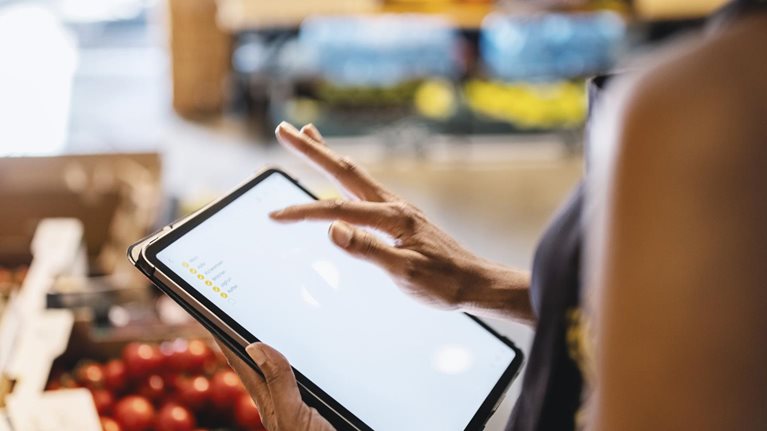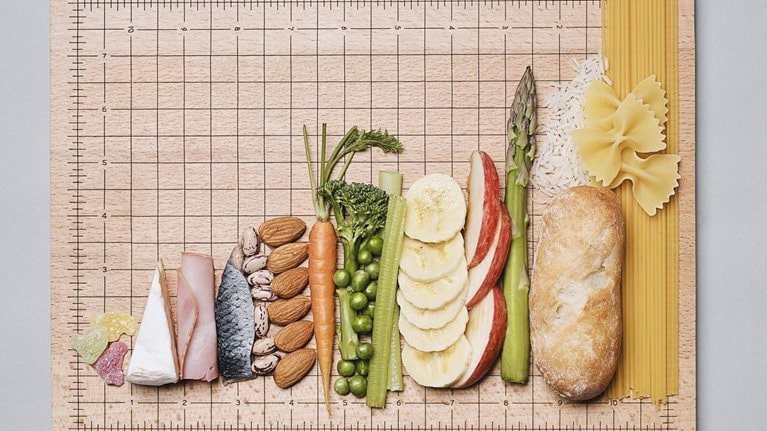Prior to the COVID-19 pandemic, the US grocery sector was lagging other retail sectors in e-commerce adoption. Customer reservations about buying fresh food online, along with high e-commerce fees and nonintuitive website designs, stunted adoption. The grocery sector’s penetration was 3 to 4 percent and significantly trailed sectors such as beauty, apparel, and electronics, all of which had penetration rates of 10 to 20 percent or more.
But the pandemic changed that trajectory. During the peak of the pandemic, grocers watched 20 to 30 percent of their business shift to online, driven by a sudden surge in demand for contactless shopping. By the end of 2020, online penetration in grocery had settled at 9 to 12 percent—a threefold increase from prepandemic levels and in line with mature markets such as France and the United Kingdom. This disruptive shift happened at breakneck speed; in a matter of months, the grocery e-commerce landscape in North America accelerated by three to five years. The e-grocery penetration in the US market is projected to get to 14 to 18 percent, or more, in the next three to five years. Here’s what we see as the new bellwethers for the next few years.
Five consumer trends shaping grocery e-commerce
Consumer preferences have changed across the board—from how and what consumers buy to their expectations for customer experience and pricing.
1. Increased online shopping is here to stay.
Despite recent increases in brick-and-mortar traffic as consumers start reverting to their shopping norms, nearly 50 percent of consumers we surveyed indicated that they buy groceries online at least once a week, representing a “next normal” (Exhibit 1). Most consumers are using e-commerce as a way to stock up or top off their weekly and monthly grocery needs, in addition to visiting a physical store. More than half of these consumers spend more than $100 per online-grocery transaction.

2. Fresh and frozen categories have gained the most traction in online demand.
All grocery categories experienced a significant increase in e-commerce adoption over the past 12 months, with shelf-stable categories such as household care, snacks, personal care, and packaged foods leading the basket mix in e-commerce. But categories that traditionally had lower representation online, including dairy, produce, fresh meat, and frozen food, also saw a significant increase in consumer willingness to buy online (Exhibit 2). What’s more, these preferences are showing stickiness beyond 2020 because of the convenience associated with buying online. This trend is similar to what we’re seeing in other parts of the world; in China, for instance, 55 percent of consumers said their preference is to continue buying more groceries online after the pandemic.

3. E-commerce modality is shifting.
The US online grocery market is evolving to a mix of instant, or same-day, delivery and click and collect. This composition is significantly different from those of more mature international markets; historically, France has been primarily a click-and-collect market (90 percent of total grocery e-commerce), while the UK market has been mainly next-day delivery (80 percent of total grocery e-commerce). In the United States, grocery-delivery services providing contactless shopping experiences accelerated a market shift toward same-day delivery, allowing more grocers to partner with third-party providers such as Instacart to quickly build their e-commerce value proposition. Moreover, food-delivery platforms such as DoorDash and Uber Eats have entered grocery delivery, and Amazon continues to drive momentum with Amazon Fresh.
In addition to its impact on delivery, the pandemic also accelerated consumer adoption of buying online and picking up curbside or in-store, with click and collect experiencing the highest increase in consumer intent to use these services, both in 2020 and beyond (Exhibit 3). Lower service fees, greater availability of time slots, and the convenience of picking up while on the road are key factors driving the increased adoption of click and collect. Grocers are also shaping this trend by investing in infrastructure to quickly build click-and-collect capabilities across their network so that they can offer a stronger customer experience. This shift will be very meaningful for grocers because click and collect offers significantly better economics compared with delivery services.

4. ‘Clunky and scrappy’ user experience is not an option.
Consumers have more choices than ever before in where to shop online. While brand strength and quality continue to be important, the user experience in the e-commerce journey is becoming increasingly relevant for consumers in deciding where to shop—a crucial point for traditional grocers to consider as they enhance their online offerings. Ease of use (for example, product selection, saved preferences, and order history for reordering) and self-serve access to information (such as stockouts, progress updates, and changes to orders) are the most important drivers of consumers’ online journeys (Exhibit 4).

5. Customers are willing to pay for convenience—to an extent.
During the COVID-19 pandemic, many grocers have responded to the crisis by promising lower service fees and “same as in-store pricing” for e-commerce. However, because of picking and delivery operations, grocers face a significantly higher cost to serve for e-commerce than for brick-and-mortar operations. As we shift toward the next normal, e-commerce service fees and pricing could push upward. However, only 36 percent of consumers indicated a willingness to pay a price premium when buying groceries online, and two-thirds would pay a premium only if it were less than 5 percent (Exhibit 5). This sentiment limits the ability of grocers to pass higher e-commerce operational costs on to customers through pricing. Grocers will need to find ways to make the value proposition profitable through other levers, such as increased basket size and operational efficiencies.

Five ways to tackle profitability
These macroshifts fundamentally changed the way consumers think about purchasing groceries, forcing grocers to quickly scale their e-commerce offerings. Now, grocers are pivoting to making e-commerce both sustainable and profitable. As e-commerce becomes a more significant portion of grocers’ ongoing business, grocers must scale e-commerce in a way that drives total shareholder value. Different players are pursuing different strategies to achieve both growth and higher profitability—or at least profit parity. At the same time, several common themes emerge in the way grocers are solving the profitability puzzle, both in the United States and globally.
1. Aggressively capture online share through a distinctive value proposition and user experience.
With the ecosystem of brick-and-mortar grocers at different levels of e-commerce maturity—and with pure players such as Amazon and third-party providers like Instacart playing in the space as well—offline share is not an indicator of “fair share” of the online market. Outside the United States, retailers such as Tesco in the United Kingdom have been able to gain a higher share of online market versus their brick-and-mortar share because of a compelling value proposition, powered by timely investments in technology and operations. Grocers that create a distinctive value proposition balancing total cost to customer (including premium pricing, delivery and service fees, and tips) with relevant product assortment and an intuitive user experience are better positioned to increase online traffic and build bigger baskets. The value proposition needs to be clearly defined across modalities (instant, same day, next day, click and collect) and in the context of the macroshift toward instant and same-day e-commerce.
2. Focus on the omnichannel value of customers.
The economics of e-commerce will continue to be challenging compared with that of brick-and-mortar stores. However, grocers that can build loyalty, personalize offers, and create incentives for customers to visit brick-and-mortar stores while also increasing their frequency and basket size of online purchases stand to gain a significant advantage. Grocers are also starting to test in-store programs and promotions to bring consumers into their online ecosystem. Even though e-commerce presents a risk of cannibalization to brick-and-mortar business, winning grocers have been able to increase their total share of wallet with existing customers by 20 to 30 percent through an omnichannel strategy.
3. Monetize digital assets.
As they have done for in-store assets via endcaps, off-shelf placements, and more, grocers are looking to monetize their digital assets by exploring new avenues to partner with consumer-packaged-goods (CPG) companies. At the same time, CPG companies are looking to invest disproportionately in digital (about 1 to 5 percent of sales) to fuel growth. This dynamic creates an opportunity for grocers to unlock new sources of revenue from CPG companies that want to secure digital space for promotions, preferential product placement on UX design, and media placement, as well as to explore data-sharing endeavors.
4. Reimagine e-commerce ecosystems and partnerships.
Several incumbents have chosen partnerships with leading ecosystems such as Amazon and Instacart to create an online route to market or provide a specific proposition. These partnerships bring scale, infrastructure, and capabilities that grocers would otherwise need years to build. However, many grocers are rethinking partnership structures to get closer to the customer and capture operational efficiencies. Strategies include renegotiating terms with third-party providers to increase access to customer data and exploring “white-label” platforms. Innovation in these partnership models will be critical to strike the right balance between serving the current needs of customers and future-proofing longer-term growth and economics.
5. Innovate in fulfillment operations.
Grocers need to optimize the mix of third-party and in-house fulfillment capabilities to create the right infrastructure to deliver on the customer promise while being cost effective and agile. For in-house fulfillment operations, the right technology will be vital to support future growth. For example, many grocers are moving toward micro-fulfillment centers to add e-commerce pick capacity in their existing spaces without creating large, automated warehouses that are capital intensive. Similarly, for delivery operations, grocers are increasingly testing gig platforms and outsourced-driver models to cater to instant and same-day e-commerce demand.
To win online, grocers need to rethink their e-commerce operating models. Unlike before the pandemic, when e-commerce accounted for 3 to 4 percent of total sales, e-commerce now requires renewed organizational focus and diligence to scale profitably. Grocers are bolstering their e-commerce-focused category teams and reviewing stand-alone e-commerce financials to sharpen their focus on this business segment. The right operating model will balance decision rights between e-commerce and merchandising teams and implement analytics and capabilities to enable acceleration in e-commerce. E-commerce in grocery is at an exciting horizon in North America; now is the time to accelerate growth while gearing the e-commerce value proposition and infrastructure for future profitability


